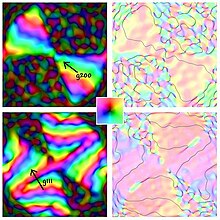Icosahedral twins




An icosahedral twin is a nanostructure appearing in atomic clusters and also nanoparticles with some thousands of atoms. These clusters are twenty-faced, with twenty interlinked tetrahedral crystals joined along triangular (e.g. cubic-(111)) faces having three-fold symmetry. A related, more common structure has five units similarly arranged with twinning, which were known as "fivelings" in the 19th century,[1][2][3] more recently as "decahedral multiply twinned particles", "pentagonal particles" or "star particles". A variety of different methods (e.g. condensing argon, metal atoms, and virus capsids) lead to the icosahedral form at size scales where surface energies are more important than those from the bulk.
Causes
When interatom bonding does not have strong directional preferences, it is not unusual for atoms to gravitate toward a
Icosahedral arrangements, typically because of their smaller surface energy,[4] may be preferred for small clusters. However, the Achilles' heel for icosahedral clustering is that it cannot fill space over large distances in a way that is translationally ordered, so there is some distortion of the atomic positions, that is elastic strain.[4] De Wit pointed out that these can be thought of in terms of disclinations,[5] an approach later extended to 3D by Yoffe.[6] The shape is also not always that of a simple icosahedron,[3] and there are now several software codes that make it easy to calculate the shape.[7][8]
At larger sizes the energy to distort becomes larger than the gain in surface energy, and bulk materials (i.e. sufficiently large clusters) generally revert to one of the crystalline close-packing configurations. In principle they will convert to a simple single crystal with a Wulff construction[9] shape. The size when they become less energetically stable is typically in the range of 10-30 nanometers in diameter,[10] but it does not always happen that the shape changes and the particles can grow to millimeter sizes.
Ubiquity
Icosahedral twinning has been seen in face-centered-cubic metal nanoparticles that have nucleated: (i) by evaporation onto surfaces, (ii) out of solution, and (iii) by reduction in a polymer matrix.
See also
- Crystal twinning
- Icosahedron
- Nanomaterial based catalyst
- Nanotechnology
- Quasicrystals
- Self-assembly of nanoparticles
